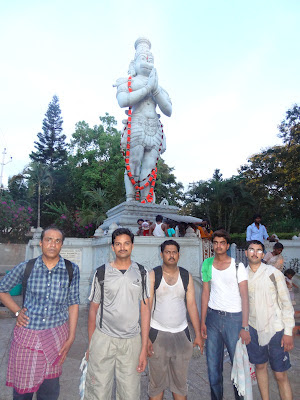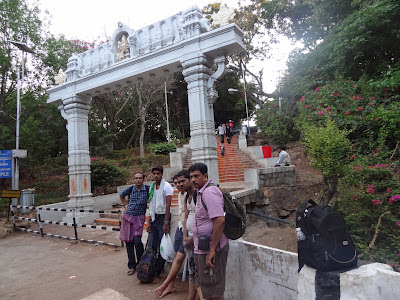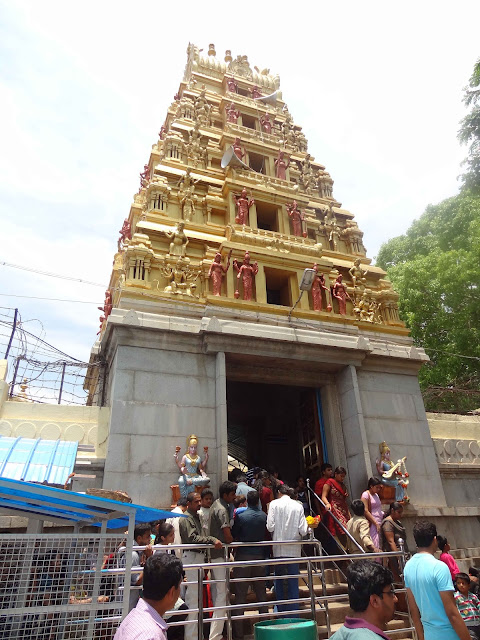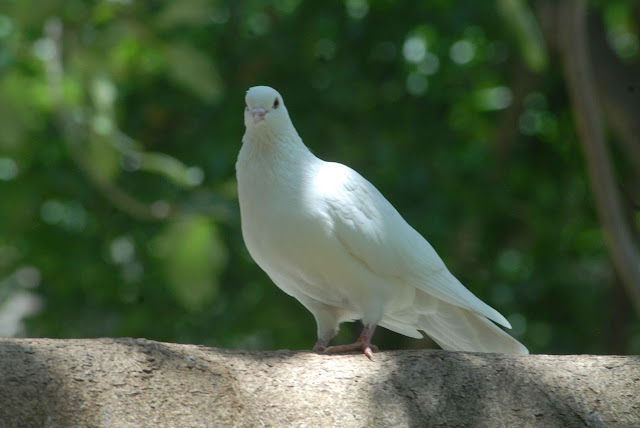Date: 23rd April and 24th April 2012
TEAM MEMBERS
Purushotham
Ramkumar
Sateesh (myself)
Kumaraswamy
Raghavendra
Rajendra
Sadananda
Prasad
Lakshminarayana
Left Bangalore on 23rd April, the train was at 7-35 pm, i have strucked at office for some urgent official work, it was tensed as we need to reach Yeswanthpur Railway Station, left office by 6-35 pm by auto from LH to Yeswanthpur, heavy traffic jam near Cauvery Petrol bunk and aslo at Sadashivnagar Signal, we are really worried can we make it! the auto which we hired the driver was also very slow, finally reached by 7-25 pm, fellow freinds are eagerly waiting near the Compartment all we get in Mr. Rajendra brought some Idli,Vade, Kharabhat and Shavigebhat from Malleswaram Railway Station
All we had nice evening snacks what Mr. Rajendra was brought, played some games (UNO-J Kumaraswamy, three time UNO Champion-Mr. Purushotham) had some tea and slept away, Train reached Tirupathi by 2am (scheduled time 2-30) caught two Autos to Alipiri reached over there had bath freely provided by TTD Authorities, by God's grace saying "EDU KONDALAVADA VENKATARAMANA GOVINDA GOVINDA' started on journey to the Divine Holy Shrine Seven Hills God Balaji, we have proceeding an small incident occured Fellow piligrim Ramkumar got low blood, giddiness only mr. purushotham was accompanying him we all almost covered nearly 2500 footsteps, he called over phone, but it was not reaching us, finally got and he informed what happened, Mr. Harsha and Mr.Kumar returned back to help him all the way 2500 footsteps down again then strength came to Mr. Purushotham, Harsha gone till further get down 100 more steps to get a cup of Coffee to him then we had a sigh of releif as he recovered from this, Purushotham and Ramkumar carried their journey in the BUS, again Mr. Harsha and Mr Kumar restarted their journey from starting from scratch once again except kumar and harsha we all reached Galigopura by 4-50 am, collected Token over there had some light tea and moved further enroute we had some nice view of the hillock all over passing and the first team reached hilltop by 7-30 am we had booked a room in Karnataka Pravasi Soudha(KPC) (0877-2277426), had once again bath, had a free breakfast (Courtesy: Mr Krishnaiah Setty, MLA, Malur Constituency, he is providing free meals to all the devotees of KPC) waited for the two men and they also reached by 09-30 am, they took some rest and they also had bath we went for having Darshan as we were entering once again Mr Kumar forget to bring the amount who was given to him to offer at Srivari Hundi, again back he went to room to bring that, finally the team dismantled
Puralapattu- take a right - Chandragiri- 36 Kms
Chandragiri take a left- TIRUPATHI app 15 Kms
Total 245 Kms
Tirupathi to Tirumala - 24 Kms
From Alipiri to Tirumala - 18 Kms
Detailed INFORMATION
before taking and tour or treks, please have some little information about the place
Some basic rules to follow while climbing the Tirumala Hill
a) Absolutely No footwear while climbing (depends on individual)
b) Travel Light (Almost all supplies can be bought on the way )
c) Have a bottle of water handy
d) Some glucose for instant energy (Please check if you are diabetic), Dry Fruits etc
e) Try to carry a backpack, to keep your hands free; but don't stuff it
f) Since the hills are sacred, people suggest to climb only after taking bath.
All we had nice evening snacks what Mr. Rajendra was brought, played some games (UNO-J Kumaraswamy, three time UNO Champion-Mr. Purushotham) had some tea and slept away, Train reached Tirupathi by 2am (scheduled time 2-30) caught two Autos to Alipiri reached over there had bath freely provided by TTD Authorities, by God's grace saying "EDU KONDALAVADA VENKATARAMANA GOVINDA GOVINDA' started on journey to the Divine Holy Shrine Seven Hills God Balaji, we have proceeding an small incident occured Fellow piligrim Ramkumar got low blood, giddiness only mr. purushotham was accompanying him we all almost covered nearly 2500 footsteps, he called over phone, but it was not reaching us, finally got and he informed what happened, Mr. Harsha and Mr.Kumar returned back to help him all the way 2500 footsteps down again then strength came to Mr. Purushotham, Harsha gone till further get down 100 more steps to get a cup of Coffee to him then we had a sigh of releif as he recovered from this, Purushotham and Ramkumar carried their journey in the BUS, again Mr. Harsha and Mr Kumar restarted their journey from starting from scratch once again except kumar and harsha we all reached Galigopura by 4-50 am, collected Token over there had some light tea and moved further enroute we had some nice view of the hillock all over passing and the first team reached hilltop by 7-30 am we had booked a room in Karnataka Pravasi Soudha(KPC) (0877-2277426), had once again bath, had a free breakfast (Courtesy: Mr Krishnaiah Setty, MLA, Malur Constituency, he is providing free meals to all the devotees of KPC) waited for the two men and they also reached by 09-30 am, they took some rest and they also had bath we went for having Darshan as we were entering once again Mr Kumar forget to bring the amount who was given to him to offer at Srivari Hundi, again back he went to room to bring that, finally the team dismantled
Myself, Raghavendra, Nani and Prasad went inside, Rajendra waited for kumar as kumar's ticket was with thim, they als entered, we four settled at Cage No. 30 saw the board over there our next darshan timing was at 2-pm they served some Curd rice who were present there by 12-30 our Cage opened and moved towards Darshan Que, Finally we had a nice Darshan of Balaji, we came back by 2-pm collected Laddus and Vada over there had some snacks at Hotel woodside and Hotel Mayura Left Tirumala by 6-00pm
We had a Dinner at Maya Restaurant nearby Railway Station, we boarded Mysore Passenger Train (8-55pm)
Reached Bangalore on 25th by 7-30 am
----------------------------------------------------------------------------------------------------
Bangalore to Tirupathi -TRAINS
By Road From Bangalore
Bangalore to Chitoor - 173 Kms
Chitoor to Puralapattu- 19 KmsPuralapattu- take a right - Chandragiri- 36 Kms
Chandragiri take a left- TIRUPATHI app 15 Kms
Total 245 Kms
Tirupathi to Tirumala - 24 Kms
From Alipiri to Tirumala - 18 Kms
Detailed INFORMATION
Basic Rules
before taking and tour or treks, please have some little information about the place
Some basic rules to follow while climbing the Tirumala Hill
a) Absolutely No footwear while climbing (depends on individual)
b) Travel Light (Almost all supplies can be bought on the way )
c) Have a bottle of water handy
d) Some glucose for instant energy (Please check if you are diabetic), Dry Fruits etc
e) Try to carry a backpack, to keep your hands free; but don't stuff it
f) Since the hills are sacred, people suggest to climb only after taking bath.
Tirupati to Tirumala on Foot
For those of you who would like to climb the hills to Tirumala to fulfil a vow, there are two well-laid stone footpaths leading to Tirumala. These paths are called sopanamargas.
The more ancient of the two sopanamargas which starts from Alipiri at the foot of the hills, is about 11 km in length, and is the commonly-used route.
The other sopanamarga (Srivari mettu) from Chandragiri, though only about 6 km in length.
For those of you who would like to climb the hills to Tirumala to fulfil a vow, there are two well-laid stone footpaths leading to Tirumala. These paths are called sopanamargas.
The more ancient of the two sopanamargas which starts from Alipiri at the foot of the hills, is about 11 km in length, and is the commonly-used route.
The other sopanamarga (Srivari mettu) from Chandragiri, though only about 6 km in length.
1.Token facility is provided for pedestrian who come on foot to Tirumala through Gali Gopuram or Srivari Mettu.
2.Bio-Metric counters are established on these foot paths, to facilitate free darshan, free accommodation (P.A.C.) and free food facilities at Tirumala.
TTD provides several facilities to pilgrims who walk up the hills to Tirumala.
2.Bio-Metric counters are established on these foot paths, to facilitate free darshan, free accommodation (P.A.C.) and free food facilities at Tirumala.
TTD provides several facilities to pilgrims who walk up the hills to Tirumala.
 |
| Foothill Steps Entrance |
 |
| The Team -[Mr.Raghavendra,Mr Purushotham, Mr.Ramkumar,Mr Harsha, Mr Kumar, Mr Lakshminarayana, Mr.Rajendra, Mr Prasad & Mr. Sadananda] |
Tirumala Venkateswara Temple is a Hindu temple in the hill town of Tirumala, near Tirupati in the Chittoor district of Andhra Pradesh. It is around 600 km (370 mi) from Hyderabad, 138 km (86 mi) from Chennai and 291 km (181 mi) from Bangalore.
The Tirumala Hill is 853m above sea level and is about 10.33 square miles (27 km) in area. It comprises seven peaks, representing the seven heads of Adisesha, thus earning the name Seshachalam. The seven peaks are called Seshadri, Neeladri, Garudadri, Anjanadri, Vrushabhadri, Narayanadri, and Venkatadri. The temple is on Venkatadri (also known as Venkatachala or Venkata Hill), the seventh peak, and is also known as the "Temple of Seven Hills". The presiding deity of the temple is Lord Venkateswara, a form of the Hindu god Vishnu. Venkateswara is known by other names: Balaji, Govinda, and Srinivasa. The temple lies on the southern banks of Sri Swami Pushkarini, a holy water tank. The temple complex comprises a traditional temple building, with a number of modern queue and pilgrim lodging sites.
The temple is the richest pilgrimage center, after the Sree Padmanabhaswamy Temple in Thiruvananthapuram, Kerala, of any faith (at more than 50,000 crore) and the most-visited place of worship in the world. The temple is visited by about 50,000 to 100,000 pilgrims daily (30 to 40 million people annually on average), while on special occasions and festivals, like the annual Brahmotsavam, the number of pilgrims shoots up to 500,000, making it the most-visited holy place in the world.
There are several legends associated with the manifestation of the Lord in Tirumala. According to one legend, the temple has a murti (deity) of Lord Venkateswara, which it is believed shall remain here for the entire duration of the present Kali Yuga.
 |
| Karpurada Arathi enroute to the hill on Footsteps |
 |
| Devotees offering Karpura Arathi in each steps |
 |
| Nani, Rajendra and Sadananda at Token Counter |
 |
| Token Counter at Gali Gopuram |
 |
| Tea Stall at GaliGopuram |
 |
| PANORAMA VIEW ENROUTE |
 |
| BLUE BELL FLOWER |
 |
| Malabal Squirrel |
 |
| Moukula Mantapam |
 |
| A View from Moukula Mantapam |
 |
| A View from Moukula Mantapam |
 |
| Team near Moukula Mantapam |
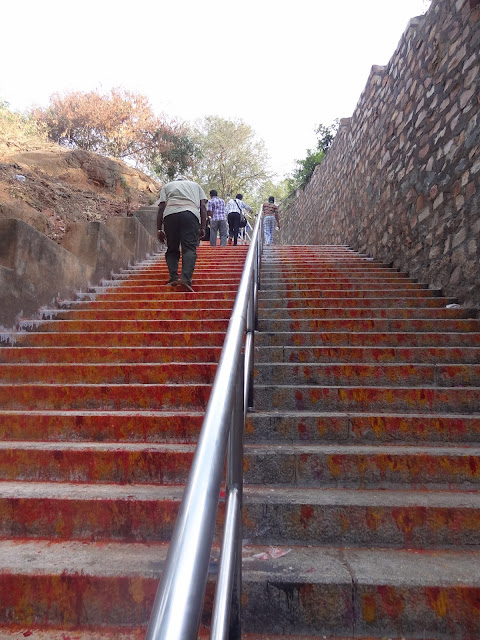 |
| Steps-Moukula Mantapam |
 |
| Tea Vendor Enroute |
 |
| Bogan Villa |
 |
| Pushkarni |
 |
| Karnataka Pravasi Soudha, Tirumala |
From the Tirumamani Mandapam, one can enter the Bangaru Vakili to reach the inner sanctum sanctorum. There are two tall copper images of the dwarapalakas Jaya and Vijaya on either side of the door. The thick wooden door is covered with gilt plates depicting the dasavataram of Sri Maha Vishnu.
The doorway is directly in line with the Padi Kavali and the Vendi Vakili. It admits pilgrims to the Snapana Mandapam. Suprabhatam is sung in front of this door.
Ramanuja
Ramanuja was the architect of Tirupati and the father of the Sri Vaishnava community there. He designed the flower gardens of the temple. He was responsible for managing the worship procedures and other affairs of the Sri Venkateswara temple. His shrine was built around the 13th century. It overlooks the western end of the Tirumamani Mandapam. There are two tall copper images of the Dvarapalas (door guardians) Jaya and Vijaya on either side of the door. The door is covered with gilt plates depicting the Dashavatara of Sri Maha Vishnu. The doorway is directly in line with the Padi Kavali and the Vendi Vakili. It admits pilgrims to the Snapana Mandapam. Suprabhatam is sung in front of this door. The right hand of the stone image of Ramanuja is held in the gesture of exposition (vyakhyana mudra), and the left hand in the form of boon bestowal (varada hasta) or of holding a book (pustaka hasta). The shrine figures prominently during the festival of Adhyayanotsavam, which is a typical Pancharatra observance. Special worship is conducted in this shrine during Gandhapodi Utsavam and Bhashyakara Utsavam. The presiding deity of Ramanuja is taken in a grand procession to meet Malayappa near the Padi Kavali.
With the call of the Divine that made today's Chinna Jeeyar Swamy the young Srimannarayana Ramanujacharyulu to take up the ascetic order of JEEYAR(Lion) at a very young age of 23 years. He is reckoned very high among the monks of the India and abroad as the pioneer and Crusader of Peace.
Annamacharya
Sri Tallapaka Annamacharya (Telugu: శ్రీ తాళ్ళపాక అన్నమాచార్య) (or Annamayya) (May 9, 1408 – February 23, 1503) was the official songmaster of the Tirumala Venkateswara Temple, and a Telugu composer who composed around 36000 keertana songs, many of which were in praise of Venkateswara, the presiding deity of the temple. The musical form of the keertana songs that he composed have strongly influenced the structure of Carnatic music compositions, which are still popular among Carnatic music concert artists. Sri Annamacharya is remembered for his saintly life, and is honoured as a great Bhakta/devotee of Bhagwaan Govinda by devotees and saintly singers. He is widely regarded as the Pada-kavita Pitaamaha (grand old man of song-writing) of the Telugu language.
Tyagaraja
Kakarla Tyagabrahmam (Telugu: త్యాగరాజు) (May 4, 1767–January 6, 1847), colloquially known as Tyāgarājar and Tyagayya, was one of the greatest composers of Carnatic music or classical South Indian music. He, along with his contemporaries Muthuswami Dikshitar and Shyama Shastry, forms the Trinity of Carnatic music. He was a prolific composer and highly influential in the development of the South Indian classical music tradition. Tyagaraja composed thousands of devotional compositions, most of them in praise of Lord Rama — most of which remain very popular even today. Of special mention are five of his compositions called the Pancharatna Krithis (English: 'five gems'), which are often sung in programs in his honor.
His compositions in praise of Lord Venkateswara include - Tirupati Venkateswara Krithis
Temple activities
Prasadam
Laddu is the world famous prasadam given at Tirumala Temple. Recently the Trust has taken copy right of Laddu prasaddam, hence, no one can prepare the same Laddu. Many other prasadams are also available including daddojanam (curd rice), pulihora (tamarind rice), vada and chakkera-pongali (sweet pongal), miryala-pongali, Appam, Paayasam, Jilebi, Muruku, Dosa, seera (kesari). Free meals are given daily to the pilgrims. On Thursdays, the Tirupavadai seva occurs, where food items are kept for naivedyam to Lord Srinivasa.
Hair tonsuring
Many devotees have their head tonsured as an offer. The daily amount of hair collected is over a ton. The hair thus gathered is sold by the temple organization a few times a year by public auction to international buyers for use as hair extensions and in cosmetics, bringing over $6 million to the temple's treasury.
When Lord Balaji was hit on his head by a shepherd, a small portion of his scalp became bald. This is noticed by Neela Devi, a Gandharva princess. She feels "such an attractive face should not have a flaw". Immediately she cuts a portion of her hair and with her magical power she implants it on his scalp. Lord Balaji notices her sacrifice. As hair is a beautiful aspect of the female, he promises her that all his devotees who come to his abode should render their hair to him, and she would be the recipient of all the hair received. Hence it is believed that hair offered by the devotees is accepted by Neela Devi. The hill Neeladri, one among seven hills is named after her.
Hundi (donation pot)
It is believed that Srinivasa had to make arrangements for his wedding. Lord Kubera credited money to the god Venkateshwara (a form of the god Vishnu) for his marriage with Padmavati. Srinivasa sought a loan of one crore and 14 lakh (11,400,000) coins of gold from Kubera and had Viswakarma, the divine architect, create heavenly surroundings in the Seshadri hills. Together, Srinivasa and Padmavathy lived for all eternity while Goddess Lakshmi, understanding the commitments of Lord Vishnu, chose to live in his heart forever. In remembrance of this, devotees go to Tirupati to donate money in Venkateshwara's hundi (donation pot) so that he can pay it back to Kubera. The hundi collections go as high as 22.5 million INR a day. Devotees offer gold as a token of their love for God. The annual gold offering goes as high as 3000 kg.
Thulabharam
One of the most important offering in this temple, is the ‘thulabharam.’ In the Thulabaram ritual, a devotee sits on a pan of a weighing balance and the other pan is filled with materials greater than the weight of the devotee. Devotees usually offer sugar, jaggery, tulsi leaves, banana, gold, coins. This is mostly performed with newborn babies or children.
Arjitha seva (paid services)
Pilgrims can view and participate (in a limited fashion) in the various sevas performed to Dhruva bera (main idol), Bhoga Srinivasa, Sri Malayappa swami and other idols in the temple.
When pilgrims purchase arjitha seva tickets, they get the opportunity to see a seva performed to the Lord, obtain prasadam in the form of vastram (clothes), akshantalu (sacred and blessed rice) and food articles (laddus, vadas, dosas, pongal, rice items) and a darshan of the utsava murti.
Thulabharam
One of the most important offering in this temple, is the ‘thulabharam.’ In the Thulabaram ritual, a devotee sits on a pan of a weighing balance and the other pan is filled with materials greater than the weight of the devotee. Devotees usually offer sugar, jaggery, tulsi leaves, banana, gold, coins. This is mostly performed with newborn babies or children.
Arjitha seva (paid services)
Pilgrims can view and participate (in a limited fashion) in the various sevas performed to Dhruva bera (main idol), Bhoga Srinivasa, Sri Malayappa swami and other idols in the temple.
When pilgrims purchase arjitha seva tickets, they get the opportunity to see a seva performed to the Lord, obtain prasadam in the form of vastram (clothes), akshantalu (sacred and blessed rice) and food articles (laddus, vadas, dosas, pongal, rice items) and a darshan of the utsava murti.
The Seven Hills
The seven hills, also called Saptagiri (Telugu: సప్తగిరి)(Tamil:ஸப்தகிரி), represent the Saptarishi (seven sages). They sometimes called the Sapathagiri. Hence the Lord is named
Saptagirinivasa. The following are the seven hills:
• Vrushabhadri (Telugu: వృశభాద్రి)( Tamil:விருஷபாத்ரி)( Kannada:ವೃಶಭಾದ್ರಿ)— Hill of
Nandi, the vahana of Lord Shiva)
• Anjanadri (Telugu: అంజనాద్రి)(Tamil:அஞ்சனாத்ரி) (Kannada:ಅಂಜನಾದ್ರಿ)— Hill of Lord
Hanuman
• Neeladri (Telugu: నీలాద్రి)(Tamil:நீலாத்ரி) (Kannada:ನೀಲಾದ್ರಿ)— Hill of Neela Devi — It is believed that hair offered by the devotees is accepted by Neela Devi. It is because of boon granted by Lord Venkateswara to Neela Devi.
• Garudadri (Telugu: గరుడాద్రి)(Tamil: கருடாத்ரி)(Kannada: ಗರುಡಾದ್ರಿ) or Garudachalam — Hill of Garuda, the vahana of Lord Vishnu
• Seshadri (Telugu: శేషాద్రి)(Tamil:ஸேஷாத்ரி) (Kannada:ಶೇಷಾದ್ರಿ)or Seshachalam — Hill of Sesha, the dasa of Lord Vishnu
• Naraynadri (Telugu: నారాయణాద్రి)(Tamil: நாராயணாத்ரி) (Kannada:ನಾರಾಯಣಾದ್ರಿ)— Hill of Narada Muni
• Venkatadri (Telugu: వేంకటాద్రి)(Tamil: வெங்கடாத்ரி)(Kannada:ವೆಂಕಟಾದ್ರಿ) — Hill of Lord Venkateswara
Festivals
Elephants marching during a festival at Tirumala
The town celebrates most Vaishnava festivals, including Vaikuntha Ekadasi, Rama Navami, and Janmashtami with great splendor, while the Brahmotsavam celebrated every year during September is the most important festival in Tirumala. The temple receives millions of devotees over the short span of a week. Other major festivals include Vasanthotsavam (spring festival), conducted in March–April, and Rathasapthami (Magha Shuddha Saptami), celebrated in February, when Lord Venkateswara's deity is taken on procession around the temple chariots.
Nearby temples
Srikalahasti Temple is an ancient temple of Lord Shiva situated on the banks of the River Swarnamukhi.The renowned devotee of Lord Shiva, Kannappa, attained salvation here. This temple is 38 kilometres (24 mi) away from Tirupati, and is connected by frequent buses.
Srikalahasti Temple is an ancient temple of Lord Shiva situated on the banks of the River Swarnamukhi.The renowned devotee of Lord Shiva, Kannappa, attained salvation here. This temple is 38 kilometres (24 mi) away from Tirupati, and is connected by frequent buses.
Srinivasa Mangapuram is situated 5 kilometres (3.1 mi) from Tirupati.This temple houses Lord Venkateswara, also known as Prasanna Venkateswara or Kalyana Venkateswara. Bus connections are available from Tirupati.
Sri Padmavati Devi Alayam (Alamelu Mangapuram), located 4 kilometres (2.5 mi) south of Tirupati, is an important temple which is visited by every pilgrim who visits Tirupati. It is this temple that houses the spouses of the Lord, Sri Padmavathi Devi (Alamelu Mangamma) and Thayaru. According to the legends, the goddess Padmavathi was born in a tank called Pushakarini at this place. The temples of Sri Krishna Swamy and Sri Sundara Raja Swamy are also inside the complex.
Sri Govinda Raja Swami Temple is located in Tirupati near the railway station. The highlight of the temple is its outer pinnacle (Gaali Gopuram), which is visible from a distance. In addition to a shrine to Sri Govinda Raja Swami, the temple complex also houses the shrines of Andal Ammavaru, Sri Krishna, Sri Ramanuja Thirumangai Alwar, Sri Vedanta Desika, Sri Lakshmi, and Sri Manevala Mahamunlu. The Bramhotsavam of Govinda Raja Swami during the month of Vaisakha (May–June) attracts a large number of devotees every year.
Sri Kodanda Rama Swami Temple is also situated in Tirupati. This temple houses the shrines of Lord Rama, Sita, and Lakshmana. The beautiful idols of this temple are famous. Bramhotsavam in this temple takes place in the month of Falgun (March–April).
Sri Kapileswara Swami Temple is the only temple of Lord Shiva in Tirupati. Pilgrims normally proceed to Tirumala for Darshan after taking a customary dip in the temple tank. Located amidst foothills of Tirumala, the place is also known for its waterfalls.
Sri Kalyana Venkateswara Swami Temple is located at Narayanavanam, according to legends. Lord Venkateswara courted and married goddess Padmavathi Devi here.
Soumyanatha Swami Temple, Soumyanatha Swami is another name and form of Lord Venkateshwara in Nandalur Kadapa District
(Source: Wikipedia)
Websites:
http://www.tirumala.org/sevas_main.htm
Tirumala Tirupathi Devasthanams E-services
If you want to enquire about TTD's e-services like e-seva, e-accomodation, e-sudarsanam or e-hundi you can contact at the following address:
Tirumala Tirupati Devasthanams
TTD Administrative Building
K.T. Road, Tirupati 517 501
Helpdesk no's : +91-877-227 7777/ 223 3333 / 226 4252 , 91-877-226 3922 for any enquiries
Tirumala Tirupathi Devasthanams E-services
If you want to enquire about TTD's e-services like e-seva, e-accomodation, e-sudarsanam or e-hundi you can contact at the following address:
Tirumala Tirupati Devasthanams
TTD Administrative Building
K.T. Road, Tirupati 517 501
Helpdesk no's : +91-877-227 7777/ 223 3333 / 226 4252 , 91-877-226 3922 for any enquiries








